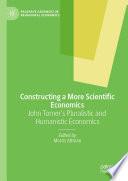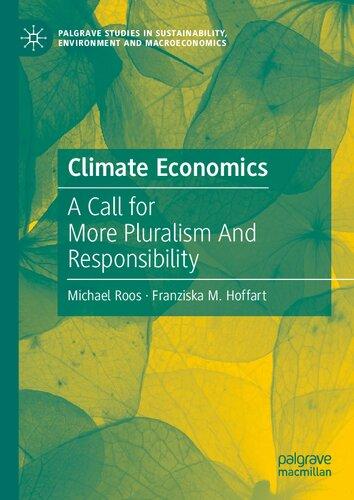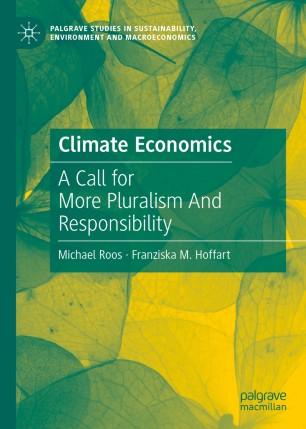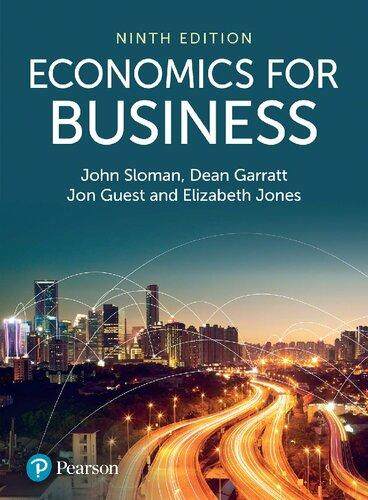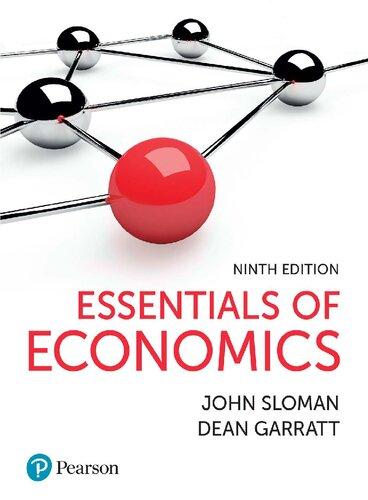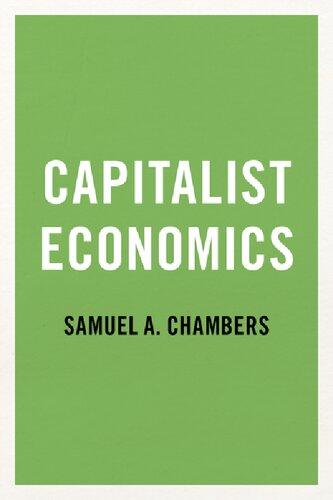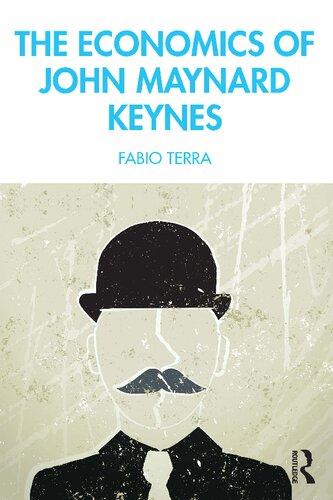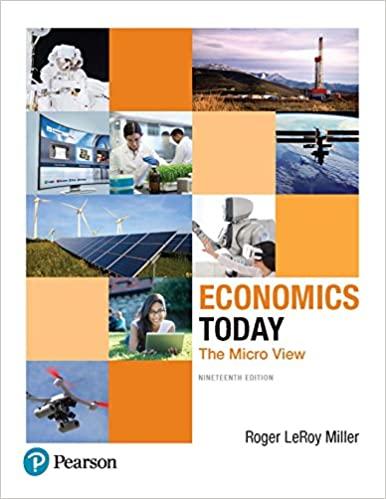Constructing a More Scientific Economics : John Tomer's Pluralistic and Humanistic Economics Morris Altman Visit to download the full and correct content document: https://ebookmass.com/product/constructing-a-more-scientific-economics-john-tomers -pluralistic-and-humanistic-economics-morris-altman/
More products digital (pdf, epub, mobi) instant download maybe you interests ...
Climate Economics: A Call for More Pluralism And Responsibility Michael Roos
https://ebookmass.com/product/climate-economics-a-call-for-morepluralism-and-responsibility-michael-roos/
Climate Economics: A Call for More Pluralism And Responsibility 1st ed. Edition Michael Roos
https://ebookmass.com/product/climate-economics-a-call-for-morepluralism-and-responsibility-1st-ed-edition-michael-roos/
Economics for Business 9th Edition John Sloman
https://ebookmass.com/product/economics-for-business-9th-editionjohn-sloman/
Essentials of Economics 9th Edition John Sloman
https://ebookmass.com/product/essentials-of-economics-9thedition-john-sloman/
Subway John E. Morris [E. Morris
https://ebookmass.com/product/subway-john-e-morris-e-morris/
Capitalist Economics Samuel A. Chambers https://ebookmass.com/product/capitalist-economics-samuel-achambers/
Capitalist Economics Samuel A. Chambers
https://ebookmass.com/product/capitalist-economics-samuel-achambers-2/
The Economics of John Maynard Keynes Fabio Terra https://ebookmass.com/product/the-economics-of-john-maynardkeynes-fabio-terra/
Economics Today: The Micro View (Pearson Series in Economics)
https://ebookmass.com/product/economics-today-the-micro-viewpearson-series-in-economics/
Constructing a More Scientific Economics John Tomer’s Pluralistic and Humanistic Economics Edited by Morris Altman
PalgraveAdvancesinBehavioralEconomics SeriesEditor JohnTomer,Co-Editor,JournalofSocio-Economics,Manhattan College,Riverdale,NY,USA
Thisgroundbreakingseriesisdesignedtomakeavailableinbook formuniquebehavioraleconomiccontributions.Itprovidesapublishing opportunityforbehavioraleconomistauthorswhohaveanovelperspectiveandhavedevelopedaspecialabilitytointegrateeconomicswith otherdisciplines.Itwillallowtheseauthorstofullydeveloptheirideas. Ingeneral,itisnotaplacefornarrowtechnicalcontributions.Theoretical/conceptual,empirical,andpolicycontributionsareallwelcome.
Moreinformationaboutthisseriesat https://link.springer.com/bookseries/14720
MorrisAltman Editor
ConstructingaMore ScientificEconomics JohnTomer’sPluralisticandHumanistic Economics Editor MorrisAltman
UniversityofDundee
Dundee,UK
ISSN2662-3846ISSN2662-3854(electronic) PalgraveAdvancesinBehavioralEconomics
ISBN978-3-030-83927-7ISBN978-3-030-83928-4(eBook) https://doi.org/10.1007/978-3-030-83928-4
©TheEditor(s)(ifapplicable)andTheAuthor(s),underexclusivelicensetoSpringer NatureSwitzerlandAG2022
Thisworkissubjecttocopyright.Allrightsaresolelyandexclusivelylicensedbythe Publisher,whetherthewholeorpartofthematerialisconcerned,specificallytherights oftranslation,reprinting,reuseofillustrations,recitation,broadcasting,reproductionon microfilmsorinanyotherphysicalway,andtransmissionorinformationstorageand retrieval,electronicadaptation,computersoftware,orbysimilarordissimilarmethodology nowknownorhereafterdeveloped.
Theuseofgeneraldescriptivenames,registerednames,trademarks,servicemarks,etc. inthispublicationdoesnotimply,evenintheabsenceofaspecificstatement,thatsuch namesareexemptfromtherelevantprotectivelawsandregulationsandthereforefreefor generaluse.
Thepublisher,theauthorsandtheeditorsaresafetoassumethattheadviceandinformationinthisbookarebelievedtobetrueandaccurateatthedateofpublication.Neither thepublishernortheauthorsortheeditorsgiveawarranty,expressedorimplied,with respecttothematerialcontainedhereinorforanyerrorsoromissionsthatmayhavebeen made.Thepublisherremainsneutralwithregardtojurisdictionalclaimsinpublishedmaps andinstitutionalaffiliations.
ThisPalgraveMacmillanimprintispublishedbytheregisteredcompanySpringerNature SwitzerlandAG
Theregisteredcompanyaddressis:Gewerbestrasse11,6330Cham,Switzerland
ToJohnTomerourdearfriendandcolleague
NotesonContributors MorrisAltman isChairProfessorofBehaviouralandInstitutional Economics,andCo-operativesandDean,UniversityofDundeeSchoolof Business,UniversityofDundee,Dundee,Scotland,UnitedKingdom.He isalsoanEmeritusProfessorattheUniversityofSaskatchewan,Canada. Heiswidelypublishedinbehavioralandinstitutionaleconomics,theories ofthefirm,andeconomichistory.
HannahJosephaRachelAltman holdsaB.Com.,BHS,M.Phil.and isinthefinalstagesofherPh.D.inbehavioralsportseconomicsat theQueenslandUniversityofTechnologyBusinessSchool(QUT)in Brisbane,Australia,underthesupervisionofBennoTorglerandRob Robergs.Shepridesherselfwithreal-worldmotivatedresearchthatstems from10yearsofinternationalfitnessindustryexperience.
GerritAntonides isEmeritusProfessorofEconomicsofConsumers andHouseholdsatWageningenUniversity,TheNetherlands.Hehas publishedresearchpapersandtextbooksintheareasofeconomic psychology,consumerbehavior,andbehavioraleconomics.
RobertAshford isProfessorofLawatSyracuseUniversity,Collegeof Law.HeholdsaJ.D.withhonorsfromHarvardLawSchoolandaB.A. inPhysicsandEnglishliterature,graduatingfirst-in-classattheUniversityofSouthFlorida.HewasaWoodrowWilsonFellowatStanford University.HeisamemberoftheAmericanLawInstituteandleading authorityoninclusivecapitalismandsocio-economics.Hispublications
includescholarshiponbanking,corporatefinance,democracy,ethics,the historyofeconomicthought,inclusivecapitalism,andtaxlaw.Hisscholarshiphasbeencitedbystateandfederalcourts,includingtheUnited StatesSupremeCourt.
AndreaH.Beller isProfessorEmeritaintheDepartmentofAgriculturalandConsumerEconomicsattheUniversityofIllinoisatUrbanaChampaign,whereshetaughtundergraduateandgraduatestudentsfor 35years.ShereceivedherPh.D.inEconomicsfromColumbiaUniversityandwasawardedtheSeniorFacultyAwardforExcellenceinResearch fromherCollegeattheUniversityofIllinois.Shehaspublishednumerous widelycitedarticlesongenderandracialdifferentialsinthelabor market,livinginsingle-parentfamiliesandchildren’soutcomes,andthe economicsofchildsupport,onwhichshealsoco-authoredabookwith YaleUniversityPress.
JohnB.Davis isProfessorEmeritusofEconomics,MarquetteUniversity, USA,andProfessorEmeritusofEconomics,UniversityofAmsterdam, TheNetherlands,andistheauthorof Keynes’sPhilosophicalDevelopment (Cambridge,1994),TheTheoryoftheIndividualinEconomics (Routledge,2003), IndividualsandIdentityinEconomics (Cambridge,2011), co-authorwithMarcelBoumansof EconomicMethodology:Understanding EconomicsasaScience (PalgraveMacmillan,2010),andco-authorwith RobertMcMasterof Health Care Economics (Routledge,2017).Heisa formereditorofthe ReviewofSocialEconomy ,andformerco-editorwith WadeHandsofthe JournalofEconomicMethodology.
JustinFerguson isaDavidsonAcademygraduatewhoplanstomajorin financeattheKelleySchoolofBusinessatIndianaUniversity.Hismain interestsarebehavioraleconomics,investments,andbusinessmanagement.
RogerFrantz isProfessorEmeritusinEconomicsatSanDiegoState University(SDSU)andtaughtbehavioraleconomicsinthePsychology departmentatSDSU.HeteachesbehavioraleconomicsatCalStateUniv SanMarcos.HewasthefoundingeditorandiscurrentlytheSpecialIssues editorforthe JournalofBehavioralEconomicsforPolicy .Heiswidely publishedinbehavioraleconomicsandthehistoryofeconomicthought, andthehistoryofbehavioraleconomics.Hislatestbookis TheBeginnings ofBehavioralEconomics (2019).
ArtGoldsmith isthe JacksonT.StephensProfessor ofEconomicsand PovertyStudiesatWashingtonandLeeUniversity,USA.Hisresearch combinesinsightsfromeconomics,psychology,sociology,andhistory toexplorequestionsregardingwages,employment,unemployment, psychologicalwell-being,accesstohealthcare,educationalaccumulation, women’sempowermentinthedevelopingworld,andthelinkbetween traumaticeventsandchildren’swell-being.Hehaspublishedarticlesin anumberoftheprofession’sleadingjournalsandhasservedonthe EditorialBoardofthe JournalofEconomicPsychology ,the Reviewof BehavioralEconomics ,the JournalofSocio-Economics ,andthe Reviewof BlackPoliticalEconomy
ShoshanaGrossbard isaResidentScholarintheEconomicsDepartmentandtheCenterforHealthEconomicsandPolicyStudiesatSan DiegoStateUniversity,foundingeditorof ReviewofEconomicsofthe Household publishedbySpringersince2003,pastFellowattheCenter forAdvancedStudiesintheBehavioralSciencesatStanford,andfounder andpastpresidentoftheSocietyofEconomicsoftheHousehold.Her booksinclude OntheEconomicsofMarriage , MarriageandtheEconomy and TheMarriageMotive(Springer,2015).Sheisaresearchaffiliatewith theFamilyInequalityNetwork(HCEO,UniversityofChicago),IZA,and GLO.
LiWayLee isaRetiredProfessoratWayneStateUniversityinDetroit, Michigan,USA.Heisanorganic,cage-freeeconomist.Lately,hethinks, reads,andwritesabouthuman’srelationwithNature.Hehasbeena memberofSABE(SocietyfortheAdvancementofBehavioralEconomics) sinceitsfounding.
GaryD.Lynne isProfessorEmeritusattheUniversityofNebraskaLincoln.Themainfieldofresearchinquiryhasbeeninboththequantity andqualityaspectsofthewaterresource,includingaspecialemphasis onwhatdrovechoicesinsoilandwaterconservationinthefarming population:ThatresearchledtocoiningtheconceptofEmpathyConservation.ItalsoledtothedevelopmentofMetaeconomics.Classroom teachingincludedcoursesinproductioneconomics,naturalresource economics,andecologicaleconomics.Forfurtherinformation,seethe Website https://www.metaeconomics.info.
ShlomoMaital isanEmeritusProfessorandheadstheZviGriliches ResearchDataCenter,attheSamuelNeamanInstituteforNationalPolicy
Research,Technion-IsraelInstituteofTechnology.HewastheAcademic DirectorofTIM-TechnionInstituteofManagement,from1998to2009, whereheworkedwithsome200companies,includingglobalfirmsand startups,andathousandmanagersandentrepreneurs.Hewassummer VisitingProfessorfor20yearsinMITSloanSchoolofManagement, teachingover1000R&Dengineersfrom40countriesfrom1984to 2003.Heistheauthor,co-author,oreditorof16booksand100 peer-reviewedarticles.
MarkPingle isaProfessorofEconomicsattheUniversityofNevada, Reno.Hisresearchhasfocusedonbehavioraleconomics,experimental economics,andmacroeconomics.Hisworkhasappearedin Journal ofEconomicBehaviorandOrganization, EconomicTheory , Journalof EconomicDynamicsandOptimalControl , TheoryandDecision,Journal ofMacroeconomics , JournalofEconomicPsychology , JournalofBehavioralandExperimentalEconomics , JournalofBehavioralEconomicsfor Policy ,andmore.Heisbookeditorfor JournalofBehavioralandExperimentalEconomics, associateeditorforReviewofBehavioralEconomics, andisapastpresidentoftheSocietyfortheAdvancementofBehavioral Economics.
PhyllisParkSaarinen specializedinwaterresourceeconomics.AspresidentofResourceEconomicsConsultants,Inc.,undercontractwith theSouthwestFloridaWaterManagementDistrict,sheresearchedwater rightstradingintheUSAandpotentialauctionmechanismsforaquifer withdrawalpermitsinover-drawnareas.Thegoalofsuchmechanisms wouldbetoevokewaterscarcityvalueandthusimproveeconomicefficiencyinwateruse.AsanAdjunctMemberoftheAmericanSociety ofCivilEngineers,sheparticipatedindraftingtheASCEModelWater CodeforEasternStates.ShealsoservedontheFloridaEnvironmental RegulationCommission1987–1991.
HughSchwartz isaYalePh.DinEconomicsandtaughtinvarious universitiesintheUSAandLatinAmerica,mostrecentlyintheUniversity oftheRepublicinUruguay,butspentthelargestpartofhiscareerwith theInter-AmericanDevelopmentBankinWashington.Hehasauthored fivebooks,fouronBehavioralEconomics,thelastofwhich,adissidenttract,is ProducerandOrganizationalDecision-Making.IsBehavioral EconomicsLosingItsWay?
CameronXu isasenioratUnionCountyMagnetSchool.Heis interestedinbehavioraleconomics,datascience,andeconomicmodeling.
ListofFigures Chapter3
Fig.1SocioeconomicFunctioning:MakingaBurgerforZoe (Source Author’sowncreation)36
Fig.2TheHumanisticHandandtheDegreeofHumanity (Source Author’sowncreation)38
Fig.3AWindingGrowthPath(Source Author’sowncreation)40
Fig.4RisingHumanitywithBoundedHead(Source Author’s owncreation)41
Fig.5DecliningHumanitywithBoundedHeart(Source Author’s owncreation)42
Fig.6ArtificialIntelligenceDrivesDownHumanity(Source Author’sowncreation)43
Fig.7MoralPersuasionDrivesupHumanity(Source Author’s owncreation)44
Chapter4
Fig.1Potentialwealth-enhancing,growth-sustainingfeatures ofanownership-broadeningeconomy66
Chapter7
Fig.1Ethics,socialresponsibilityandX-efficiency135
Chapter10 Fig.1Theshareofadultsthatareobese,1975to2016(Source Ritchie,Hannah[2017].“Obesity”.Publishedonline atOurWorldInData.org AccessedDecember19,2020, Availableat:https://ourworldindata.org/obesity)207
Fig.2Shareofadultsthatareoverweightorobese,1975to2016 (Source Ritchie,Hannah[2017].“Obesity”.Published onlineatOurWorldInData.org AccessedDecember19, 2020,Availableat:https://ourworldindata.org/obesity)208
Fig.3Lifeexpectancy,1910to2015(Source Roser,Max, EstebanOrtiz-OspinaandHannahRitchie[2013].“Life Expectancy,” OurWorldInData.org. AccessedJanuary3, 2021,Availableat:https://ourworldindata.org/life-expect ancy)209
Fig.4Shareofdeathsattributedtoobesity,1990to2017(Source Ritchie,Hannah[2017].“Obesity”.Publishedonline atOurWorldInData.org. AccessedDecember19,2020, Availableat:https://ourworldindata.org/obesity)210
Fig.5Deathratefromobesity,1990to2017(Source Ritchie,Hannah[2017].“Obesity”.Publishedonline atOurWorldInData.org AccessedDecember19,2020, Availableat:https://ourworldindata.org/obesity)211
Fig.6Annualfoodexpenditureperpersonvs.GDPper capita,2015(Source Roser,MaxandHannahRitchie [2013].“FoodPrices,”OurWorldInData.org.Accessed January3,2021,Availableat:https://ourworldindata.org/ food-prices)212
Fig.7Shareofadultmenoverweightorobesevs.dailysupply ofcalories,2013(Source Ritchie,Hannah[2017]. “Obesity”.PublishedonlineatOurWorldInData.org AccessedDecember19,2020,Availableat:https://ourwor ldindata.org/obesity)213
Fig.8HealthyvsUnhealthyFoodDemand222
Fig.9TheIncomeeffect&FoodandBeverageConsumption226
Fig.10Calories,WeightGain,andEducation227
Chapter13
Fig.1Globalmeantemperaturechangevs.atmosphericcarbon dioxide(partspermillion),1880–2019(Source https:// www.climatecentral.org/gallery/download/global-temper atures-and-co2-concentrations)286
Chapter15 Fig.1Industrialinputs(d)joint(nonallocable)withwater conservationinputs(e)toproduceafoodproduct fromirrigationagricultureintheself-(private)interest (I G )andacommunityenvironmentalproduct intheother-(public)interest(I M )(Source Authororiginal)314
Fig.2Synergyonthefoodandcommunityenvironmental productionpath,balancingtheprivateinterestinthemarket basedfoodproductwiththepublicinterestincommunity environmentalproductsonahigherplaneofValue V (Source Authororiginal)316
ListofTables Chapter9
Table1Factorsinconsumerdecision-makingonhealthy andsustainablefoodandtheirtypicalfocus173
Table2Structureoffoodchoicedeterminants184
Chapter10
Table1Gymmembershipandattendance219
CHAPTER1 Introduction 1 Introduction ThisbookhonoursthememoryofJohnTomer,whopassedaway on7December2019.Werememberthemultifacetedcontributionsof John.ThisbookbringstogetherthecontributionsofsomeofJohn’s closefriendsandcompatriots—manyofwhoseapproachestobehavioural economicsdifferfromJohn’s.Butthiscelebrationandacceptanceof differencewascoretoJohn’sapproachtoacademiclife.
Sadly,wearemissinginthisbooksomecontributionsfromoldfriends whohavesinceretiredbutplayedanimportantroleinJohn’slife.Itis importanttomentionCharlottePhelps,EmeritusProfessor,atTemple University,whowasinvolvedwithSABEfromtheverybeginningand Partofthisintroductionborrowsfrommyintroductionofthespecialissueof the JournalofBehavioralEconomicforPolicy ,publishedin2021(https://sab economics.org/jbep/).
M.Altman(B) UniversityofDundee,Dundee,Scotland,UK e-mail: maltman001@dundee.ac.uk
©TheAuthor(s),underexclusivelicensetoSpringerNature SwitzerlandAG2022
M.Altman(ed.), ConstructingaMoreScientificEconomics,Palgrave AdvancesinBehavioralEconomics, https://doi.org/10.1007/978-3-030-83928-4_1
MorrisAltman
attendedmostSocietyfortheAdvancementofBehaviouralEconomics (SABE)meetingsoverfourdecades,andBijouLesterYangwhowas along-timeSABEtreasurerfrom1992atacriticaltimeinitshistory. AndthenthereisLouisLevy-Garboua,apastpresidentofSABE,now retired,fromUniversitédeParisIandParisSchoolofEconomics, Centred’économiedelaSorbonne.Finally,ImustmentionRichard Hattwick,whocreatedandwasthefoundingeditorofthe Journalof BehaviouralEconomics (later,the JournalofSocio-Economics )intheearly 1970s,whosharedwithJohnandothersanopen-mindedandinclusive methodologicalapproachtobehaviouraleconomics.
2 JohnTomerandSABEandBigTentThinking Johnwasnotonlyaninnovativethinker,buthealsoplayedavitalorganizationalroleinthedevelopmentofbehaviouraleconomics.Insodoing, heheldadoorwideopentobothyoungerandoldercolleagueswho thoughtoutsideofthemainstreamboxusingwhatevermethodologicalapproachwasbelievedtobemostappropriate.Disagreeingwith Johnnevermeantbeingdenigratedor‘disappeared.’Itonlymeant beingsubjecttounendingandprobingquestionsfromJohn.Fundamentally,Johnwasapluralistinhisapproachtobothscholarshipand organization-building.Thisledtohisearlyorganizationalworkinthe foundingoftheSocietyfortheAdvancementofBehaviouralEconomics intheearly1980s.Actually,SABEwasfoundedin1982byJohn TomeralongwithGeorgeAkerlof(Berkeley),RichardCurtin(Michigan), RogerFrantz(SanDiegoState),ShoshanaGrossbard,(SanDiegoState), ThomasJuster(Michigan),HarveyLeibenstein(Harvard),FredvanRaaij (Erasmus,Rotterdam),HaroldShapiro(Michigan),andHerbertSimon (Carnegie-Mellon).SABE’sfirstmeeting,attendedbyJohn,wasorganizedbyBennyGilad(RutgersUniversity),whichwasheldin1984 atPrincetonUniversity.ThiswasfollowedbyaSABEmeetingorganizedbyShlomoMaitalatKibbutzShefayim,Israel,inwhichJohnalso participated.
Then,behaviouraleconomicswas,morethananything,abigtent concept,workingtotransformeconomicsbyintroducingnon-traditional conceptsintoeconomicnarrativesandalsoallowingforbothmathematicalandnon-mathematicalapproachestotheorizing.Thisfollowed fromtheearlycontributionsofHerbertSimontothedevelopmentof
behaviouraleconomicsasamoreenrichedapproachtoeconomicanalysis,counterposedtotherathernarrowneoclassicalframeworkasithad developedintothesecondhalfofthetwentiethcentury.Thisearlyversion ofbehaviouraleconomicswasverymuchopenandembracingofamultiplicityofdisciplinaryperspectives.ButJohnwasalsointerestedinsocial justiceandthecapacityofeconomicscontributingtoimprovingallof ourlives.Economics,forJohn,wasnotsimplyaboutabettereconomics toolbox,butratheranenrichedtoolboxthatcouldcontributetowards improvingsocialandindividualwell-being.ThisledhimtohislongstandinginvolvementwiththeAssociationforSocialEconomics,where socialjusticeconcernsandthecontributionofeconomicstotheseare ofpreeminentimportance.And,justabouteveryyearJohnwouldbe presentingapaperattheAssociationforSocialEconomicsmeetings whichtookplaceundertheauspicesoftheAlliedSocialAssociation Meeting(ASSA).
Onapersonalnote,Johnwasalsoadearfriend.I’veknownhimsince 1988.IfirstmetJohnduringanimpressiveAdvancementofBehavioural Economics(SABE)meetinginSanDiegoorganizedbyRogerFrantz. RogerinvitedtothisSABEmeetingwhenwewereattendingaworkshophonouringthecontributionsofHarveyLeibensteinattheRockefellerFoundationBellagioCenterinLakeComoinNorthernItaly.At thattime,IactuallyneverhearofSABE.And,Iwasmorefocusedon mainstreamorganizations.So,theBellagiomeetingandbeingintroduced toSABEwasapivotalmomentearlyoninmycareer.Whenattendingthe SanDiegomeeting,I’donlyjustreadJohn’snewlypublished, OrganizationalCapital:ThePathtoHigherProductivityandWell-being .Atthis time,Icouldonlysayhiandaskafewquestionsabouthisresearchwhich overlappedwithmyown.Hewasquitebusyfieldingquestions.
3 TheDeathandRe-BirthofSABE Soonafterthe1988meeting,SABEwasfoldedintothenewlyformed SocietyfortheAdvancementofSocio-Economics(SASE)headedbysociologistAmitaiEtzioni.Buteconomicswaslostintheoverwhelmingly sociologicaluniversethatwaslargelyantitheticaltoeconomicsasadiscipline.Eventheopen-tentSABEhaddifficultiesfindingatruehomein SASE.Fundamentally,Johnwasaneconomistwhosawtheimportance ofeconomicsasdiscipline,butadisciplinethathadbecomeincreasingly short-sightedandsmall-minded.
Therewasaneedforachange.And,JohnandIbecamegoodfriends soonafterameetingtorevivethenewlydefunctSABEwhichtook placeduringanAmericanEconomicAssociationmeetinginNewOrleans, January1992,organizedbyJohnandShlomoMaital.
JohnbecamethefirstandlongservingPresidentofSABE.Shlomoand Ibecametheco-editorsofournewsletterandpartoftheSABEexecutive. LiWayLee(Secretary)andBijouLesterYang(TreasurerandfutureSABE President),whoparticipatedinthisfoundationalmeeting,alsobecame vitalmembersofthis‘bornagain’SABEexecutiveteam.Inthe1993, JohnorganizedtheSABE‘revival’meetinginRensselaerville,NewYork. Underhisleadership,SABEgrewfromabout30membersinitsnewly reconstitutedformtowellover400members.SABEwasandcontinues tobemadeuplargelyofeconomistswhoarelargelyattractedtoits open-tentesprit,championedbyJohn.Johnparticipatedinjustabout everySABEandjointSABE/InternationalAssociationforResearchin EconomicPsychology(IAREP)meetingsince1992.IAREPbecamean increasinglyimportantpartnerofSABE,withthelattercentredinthe UKandtheEuropeansub-continentandlargelycomprisingofnoneconomists,mainlyeconomicpsychologistswitharatherstrongrepresentationofeconomists.SABE,onceagainwiththestrongsupportof John,soonbeganatraditionofholdingmeetingsinbothNorthAmerica andEurope.JohnandIwouldalwayshookupandhangoutduring thesemeetings,veryoftenwithhiswifeDorisandmywifeLouiseand daughterHannah.Thiswasallpartofamissiontoestablishandmaintain arigorous,open-mindedacademicorganizationdevotedtobehavioural economics.
4 TheLifeandTimesofJohn TomerinaFewParagraphs
IshouldsaythatJohnandIdisagreedonmanymethodologicaland evenorganizationalissues.ButwhatwassoimportantaboutJohnwas hisopen-mindedness,hisimbuedsenseofmethodologicalpluralism,his viewthatwhatcountsisthepersonandherorhisresearchnotwherethis personcamefromorwhichuniversitytheygraduatedfrom.So,being opentodisagreementanddebatewasnaturaltoJohn.And,thisperspectiveisfundamentallyimportanttoSABE.ThisiswhatprovidesSABE withitsdistinctiveness.
Johnearnedhisdoctoratein1973atRutgersUniversity.Histhesiswas entitled,“ManagementConsultingforPrivateEnterprise:ATheoretical andEmpiricalAnalysisoftheContributionofManagementConsultantstoEconomicGrowthintheUnitedStates.”And,thisunderpinned hislifelonginterestinhowfirmsactuallyoperatedandhowreal-world decision-makersfunctionedinsideofthefirm.John’sthesissupervisor wasProfessorRobertJ.Alexanderwhowasapoliticaleconomist,a socialactivist,andatradeunionist,withapassionateinterestinthe humancondition.John’sinitialpointsofscholarlyfocuswere:monetary theory,publicfinance,labourandhumanresources,econometrics,and theeconomicsoftechnologicalchange.
JohnspentmostofhiscareerinManhattanCollege,locatedinthe Bronx,NewYork(1983–2012),untilhisretirement.ButJohnandhis family(hiswifeDorisandsons,RussellandJeffrey)maintainedtheir residenceinTroy,NewYork,thelocationofRensselaerPolytechnicInstitutewhereJohntaughtfrom1974to1981.Inspiteofbeingina moreteaching-intensiveuniversity,Johnremainedaheavy-dutyresearcher andpublisher,makingsignificantcontributions,especiallyinbehavioural andsocialeconomics.And,ManhattanCollegeprovidedJohnwiththe supportrequiredtopursuehisresearch.Hepublishedfivebooksand aroundsixtypeer-reviewedjournalarticlesandbookchapters.Andhe wasstillactivelyworkingonresearchprojectsatthetimeofhisdeath.
Johnwasbornon11July1942,andpassedawayon7December2019. Thiswasonlythreemonthsafterwemetforthelasttimeduringhislast SABEmeetingthattookplaceinDublin,Ireland.Hemadethistripin spiteofbeingquiteillwithcancer.Hewasdeterminedtoonceagainmeet withhisfriendsandcolleagues,makenewacquaintances,attendsessions (andaskquestions,ofcourse),andpresentaresearchpaper,ashealways wouldduringaconference.Johnwouldnotletthecancergetthebetter ofhimuntiltheveryend.And,eveninDublin,heexudedmoreenergy thanmanyofhismuchyoungercolleagues.Johnwasonlyabletomakeit thistimearoundwithhiswifeDoris,whoaccompaniedhimonsomanyof hisresearchtrips.Weallhungoutalongwithmydaughter,Hannah,now aneconomistinherownright,whoattendedmostofJohn’spresentations duringSABEandIAREPmeetingssinceherbirth,26yearsago.
ThelastpaperthatJohnpresentedwas,“WhyBuddhisteconomicsIs needed:Overcominglargescalebiophysicalandsocio-economicdysfunctions.”Thiswasanareathathewasinterestedinfordecadesandalso informedmuchofhisthinking.Wepromisedtomeetupagainduring
theforthcomingAmericanEconomicsAssociationmeetingsinJanuary, anothertraditionthatbeganinthe1990s.Butthiswasnotmeanttobe. ButJohn’slegacylivesonthroughhissignificantorganizationalcontributionsandhismanycontributionstoresearchwhicharecelebratedin thisspecialissue.Foryourinterest,intheAppendix,thereisJohn’s appreciatedCV,withthelisthiscontributionstotheliterature.
5 ContributionstotheTomerBook Thecontributionstothisvolumetouchonmanytopics.Onamore personalnote,ShlomoMaital’s“BehavioralEconomicsandtheBirth (andRebirth)ofSABE:TheLegacyofJohnTomer”providesimportant insightsontheevolutionofbehaviouraleconomicsandSABEandJohn’s andhisownroleinthis.ThisoverlapswithsomeofthepointsthatI addressabove.ShlomowasoneofthepioneersofSABEandcriticalto itsre-birth.
ThegeneraldiscussionofthelifeandtimesofJohnTomerisfollowed bychaptersthatareinspiredbyJohn’seffortstointroducehumaneand humanfactors(real-worldeconomicactorswithreal-worldcharacteristics)toeconomicanalysis.Inthechapter,“Tomer’sHumanisticHand,” LiWayLeespeakstotheinteractionbetweenTomer’s‘humanistichand’ andthemorecalculatingmodellingoftraditionaleconomics,tolocate meanstoreducecurrentsocioeconomicdysfunctions.Leearguesthat thisrequiresanunderstandingoftheinteractionbetweentheuseofthe ‘heart’and‘head’(morecalculatingneoclassical)foreconomicanalysis andpolicy.Hefavoursamorebalancedapplicationofheartandheadto contributetoamorehumanesociety.GaryLynne(along-timeformer SecretaryofSABE)andPhyllisSaarinenalsodiscusssocioeconomic dysfunctionintheirchapter,“MetaeconomicSolutionstoDysfunctional WaterMarkets.”Theycritiquethestilldominantassumptionthatprivate propertyandnarrowself-interestedbehaveisthe only wayofachieving economicefficiencyinwatermarkets.Theyarguethateconomicefficiency canbebetterachievedbybalancingselfandother-interest,themarket, andgovernment.Thisapproachwillavoiddysfunctioninwatermarkets. Inthischapter,“InclusiveCapitalism,”RobertAshford(aProfessorof Lawandalong-timefriendofJohn),arguesforadifferentanalytical framework,whereinabroaderdistributionofcapitalacquisitionwith futurecapitalearningswillyieldgreatergrowth,amoreegalitariandistribution,andgreaterincentivestoemploylabour.Here,onehasamore
egalitariandistributionofincomewithoutaredistributionofincome. JohnDavisdiscusseshowJohnTomer’smultidimensionalandinterdisciplinaryperspectiveonhumancapitalformationcancontributetoabetter understandingofhumandevelopmentandtotheadvancementofamore humanesociety,inhischapter,“JohnTomer’sReconceptualizationof theConceptofHumanCapital.”Ofparticularimportanceisthecapacity ofindividualstoinvesttheirhumancapitalwherethiscapacityisseriouslywantingforlargesegmentsofthepopulation.JohnDavishasbeen aleadingscholarandactivistinsocialeconomicsandintheAssociation forSocialEconomics,whichplayedanimportantroleinJohnTomer’s academicandsociallife.
ThetheoryofthefirmplayedanimportantroleinJohnscholarship, beginningwithhisdoctoraldissertation.ForJohn,howthefirmwas organizedplaysadeterminantroleinitsproductivityandinitscontributiontoworkerandsocialwell-being.WritingwithJustinFerguson andCameronXu,MarkPingle,intheirchapter,“JohnTomer’sHuman Firm:HowBehavioralEconomicsHasHelpedUsUnderstandtheFirm,” examineshowextendingtheneoclassicalmodeltoincorporatehuman factorsenrichesourunderstandingofthedeterminantsofafirm’sproductivity.Thesetypicallyintangiblevariablescannotonlypositivelyaffect productivitybutalsothewell-beingofallfirmmembersandsociety asawhole.MarkPringlehasbeenalong-standingmemberofSABE andservedasaPresidentofSABE.HewasactuallyrecruitedbyJohn TomerafterMarkgotJohninvolvedina JournalofEconomicBehavior andOrganisation initiativesomedecadesago.Inmychapter,“CommunityEmbeddedness,ConsumerVoice,CorporateSocialResponsibility,” IbuilduponTomer’stheoreticalperspectivesonthehumanandmore humanefirm.Imodelwhythereisnomarketimperativeformfirms tobecomemorehumaneeveniftheyaremoreproductive,buthow effectiveconsumervoice,communityembeddedness,knowledgeofthe profitabilityofbeingmorehumane,andfearofgovernmentintervention incentivizethedevelopmentofamorehumanefirmandsociety.In“John Tomer,X-EfficiencyTheory,andBehavioralEconomics,”RogerFrantz,a long-timecolleagueofJohnandaleadingplayerinSABEandx-efficiency theoryscholar,criticallydiscussesJohn’sapplicationofx-efficiencytheory tohismodellingofthefirmandhowthisfitsintoHarveyLeibeinstein’s pioneeringdevelopmentofx-efficiencytheoryandthetheoryofthefirm. Thenexttwochaptersspeaktoanareaofresearchandpublicconcern thatwasveryhighonJohn’sprioritylist:consumerbehaviourandhealthy
eatingandliving.GerritAntonides’chapter,“TheBehavioralEconomics ofHealthyandSustainableFoodConsumption,”surveystheliterature onthedeterminantsofconsumerchoicewithregardtohealthyversus relativelyunhealthyfood.Poorchoicescanresultinobesityandrelated healthproblems,whichwasverymuchaconcernofJohnTomer.Gerrit investigatesnon-pricedeterminantsofconsumerfoodchoicebehaviour suchassocialnorms,defaults,andemotionalappealsasimportantmeans ofshiftingconsumerchoiceawayfromunhealthyfoods.Gerritwasone oftheleadingvoicesofthebornagainSABEandplayedacriticalrolein forgingavibrantpartnershipbetweenSABEandIAREP.Healsoserved asaPresidentofSABEandwasagoodfriendofJohn.Inthechapter, “Obesity,Wellbeing,FreedomofChoice,andInstitutionalChange,” HannahJosephaRachelAltmanandIbuildonsomeofJohn’sinsights onthedeterminantsofunhealthyeatingandobesitytoextendthepricebasedhomogenousagentmodelofconsumerchoicefortheinputsfor healthylivingsuchasfoodandexercise.Wearguethatrelativeprices andincomeareimportanthereasareincomecohorts.Butwealsoargue thatvariablessuchasinformation,accesstohealthyfoods,andsafeand affordablespaceforexercisearekeydeterminantsofhealthliving.More importantthanthestatenudgingconsumersintobehavinginparticular fashion,wearguethatitisbesttoimproveindividuals’decision-making environmentsandcapabilities.
Twochaptersaredevotedtotheeconomicsofthehousehold,broadly speaking.In“AssessingtheNewHomeEconomicswith2020Vision,” ShoshanaGrossbardandAndreaBellerreviewtheliteratureontheNew HomeEconomics(NHE),pioneeredbyGaryBeckerandJacobMincer, towhichShoshana,whosePhDdissertationofwassupervisedbyBecker, madeimportantcontributions.Theyalsoattempttoevaluatethesuccess oftheNHEprojectbasedonthecriteriasetoutinthischapter.Although theNHEisverymuchinthetraditionofneoclassicaleconomics(price theory),itaddsavitalsociologicaldimension,takingusbeyondboth pricetheoryandpsychologicalvariables.Shoshanaplayedafoundational roleinSABEfromitsverybeginnings,wasamemberoftheSABEexecutive,organizedSABEmeetings,attendedanabundanceofSABEand SABE/IAREPmeetings,andremained,throughout,agoodfriendof John.ArtGoldsmith,inhischapter,“IntergenerationalInequalityand Parenting:MakingRoomfortheParent–ChildRelationship,”buildson JohnTomer’sinsightsontheimportanceofthequalityofchild-parent relationshipforthechild’scurrentandfuturehumancapitalformation
and,therefore,forherorhissocioeconomicwell-beingasanadult.This representsacritiqueofGaryBecker/JamesHeckmanfocusontimeand resourcesasbeingofpenultimateimportance,arguingformoreattention beingdevotedtothesignificanceofthenon-material‘softer’inputs(in additiontomaterialconsiderations)intoachild’songoinghumancapital formation.ArtwasanearlySABEparticipantservingonitsexecutive withJohnTomerandorganizingoneitsimportantannualmeetingson thecampusofWashingtonandLeeUniversityinLexington,Virginia.
Thefinaltwochaptersofthisbookareexplicitlydevotedtopublic policyandmethodology.AmajorconcernofJohnTomerwashow behaviouraleconomics,especiallyitsmorepluralistvariants,canimpacton publicpolicyandthemethodologyunderlyingeconomictheory.Shlomo Maitalinhischapter,“CrossingtheValleyofDeathBetweenAcademic ResearchandEffectivePolicy:TheRoleofBehavioralEconomics,” addressestheissueofwhyhaveeconomistfounditdifficulttohavetheir researchfindingsbetterunderstoodbythepublicandimplementedinto policy.Hearguesthatthisisinpartduetotheeconomicsprofession rejectionofthebehaviouralapproachchampionedbyMarshallandits adoptionofstrictmathematicalapproachofWalraswhilstalsorejecting ethicalandmoralconsiderationsfromitscorpus.Maitalismorehopeful withthemorerecentadoptionofbehaviouralistapproachtoeconomic analysesalongwiththeriseinsignificanceofrandomizedcontrolled experimentsasanempiricalfoundationofbehaviouralistmodelling. In“BehavioralEconomics,PublicPolicyandBasicDecision-Making,” HughSchwartzarguesforamorenuancedapproachtodecision-making, breakingawayforthesimplifyingassumptionoftheaverageindividualas theidealguideforunderstandingthedeterminantsofdecision-making andasaguideforgoodorsuccessfuldecision-making.Schwartzargues thatthisapproachignoresthevitalimportanceofunderstandinghow themostsuccessfulindustryleadersbehave,andhowtheyengagein decision-making.Heoutlineshowtoincorporateanunderstandingof theseoutlierstogenerateabetteroverallunderstandingofthebehaviour oforganizations,especiallyofwinningorganization.Thismoreenriched modellingcancontributetomoreenlightenedpolicyinthisdomain.
